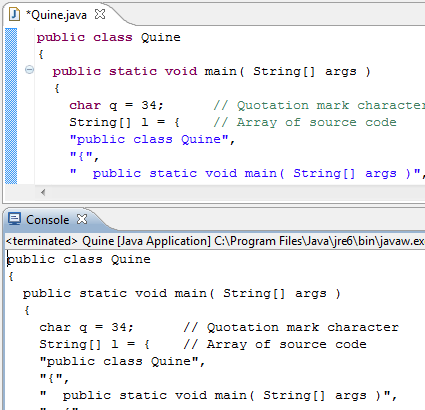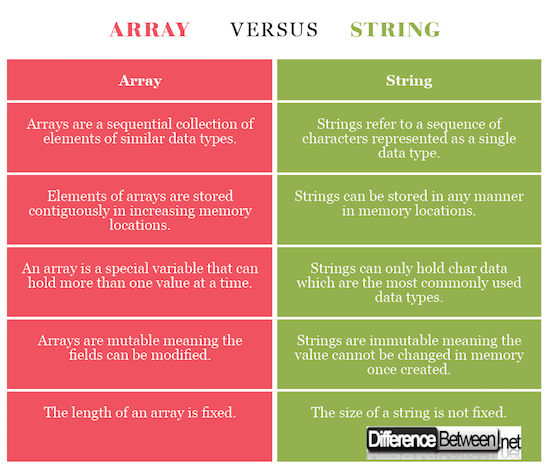Difference between Array and String
The main difference between the two is that arrays can have any data type of any length while strings are usually ASCII characters that are terminated with a null character ‘\0’. Both are very different in terms of how they are being implemented in various programming languages. Arrays and strings work very differently in Java as they do in C/C++. This article presents an unbiased comparison between Arrays and Strings.
What is an Array?
Many applications involve large volume of data and to process such large amounts of data, we need a powerful data type that would facilitate efficient storing and accessing of data items. This is where arrays come to the picture. Arrays are a special variable that refer to a sequential collection of like-type variables that are referred to by a common name. In technical terms, it’s a sequenced collection of elements of the same base types that share a single name. Simply put, it provides a convenient means of grouping related information together. Arrays in Java work very differently than they do in C/C++.
What is a String?
A string is a sequence of characters that is represented as a single data item that is terminated with a special character ‘\0’ (null character). In Java and C++, strings are classes and they behave differently. Strings are declared similarly as arrays with the exception of char type. String is a contiguous sequence of values with a common name. Unlike arrays, strings are immutable which means their values cannot be modified once they are assigned. The original content of the string cannot be changed once a value is allocated to the string. They are one of the most used classes in programming paradigm.
Difference between Array and String
Definition
An array is a fixed-size sequenced collection of elements of the same base types. It is simply a collection of like-type variables that share a single name and can be used to represent a list of names or a list of numbers. A string is similar to an array with a few exceptions. It is a sequence of characters that are represented as a single data item.
Storage
One of the main differences between an array and string is how they are stored in memory. A contiguous memory block is allocated for an array meaning it represents a continuous block of memory. The elements of arrays are stored contiguously in increasing memory locations. Strings are stored like other types of arrays when they are declared as character arrays. A string class contains a pointer to some part of the heap memory where the actual contents of the string are stored in memory.
State
One of the key differences between the two is that strings are immutable which means once a string object is assigned, the value of the object cannot be changed in memory. Immutable simply refers to a state of object which cannot be modified after it is created. The original content of the string cannot be modified once a value is allocated to the string. It simply means the new value cannot be assigned the same address in the memory location where the previous value was stored. Arrays, on the other hand, are mutable meaning the fields can be changed or modified even after it is created.
Data Type
Arrays are the most efficient data structure for representing data or storing and accessing objects of the same or different data types. They are dynamically created and can be assigned to variables of any data types. In java, an array can be created so as to hold different data types. It can hold primitives as well as references. Arrays are special variables that are able to hold more than one value at a time. Strings, on the other hand, can only hold char data which are the most commonly used data types. Character strings can hold any sequence of letters and digits.
Size
The length of an array is established when it’s created and once done, the length is fixed. Simply put, length of array has a fixed size meaning it can hold a fixed number of values of a single type. Variable size arrays are not allowed in C. Once an array is allocated, it’s a fixed size. The size of a string is variable meaning it can be changed if it’s a char pointer.
Array vs. String: Comparison Chart
Summary of Array vs. String
Strings and arrays are quite similar except the length of an array is fixed whereas strings can have a variable number of elements. Technically, arrays are a special type of variable that can hold more than one value at a time. They are a sequential collection of elements of similar data types, whereas strings are a sequence of characters used to represent text rather than numbers. In addition, strings are immutable which means the value of an object cannot be modified once it’s created, while arrays are mutable meaning the fields can be modified. Simply put, an array is a collection of like-type variables whereas a string is a sequence of characters represented by a single data type.
- Difference Between Caucus and Primary - June 18, 2024
- Difference Between PPO and POS - May 30, 2024
- Difference Between RFID and NFC - May 28, 2024
Search DifferenceBetween.net :
1 Comment
Leave a Response
References :
[0]Franek, Frantisek. Memory as a Programming Concept in C and C++. Cambridge: Cambridge University Press, 2004. Print
[1]Schildt. C: The Complete Reference. NYC: Tata McGraw-Hill Education, 2000. Print
[2]Gregoire, Marc. Professional C++. New Jersey: John Wiley & Sons, 2014. Print
[3]Image credit: https://commons.wikimedia.org/wiki/File:QuineProgram.png#/media/File:QuineProgram.png
[4]Image credit: https://upload.wikimedia.org/wikipedia/commons/thumb/7/7c/Java-greeting-app-source-code.png/640px-Java-greeting-app-source-code.png




Hi,
Thank you so much for clear explanation and sharing with us.
Regards,
Zafar